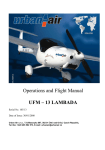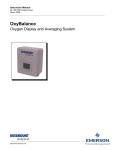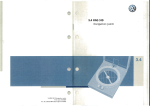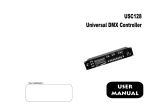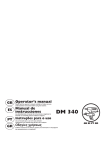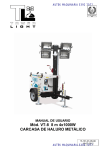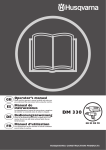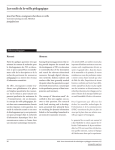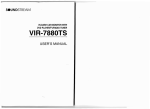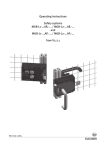Download Urban Air UFM - 13 LAMBADA Technical data
Transcript
OPERATING AND MAINTENANCE MANUAL FOR ULTRALIGHT AEROPLANE UFM-13 Lambada 1. GENERAL 1.1. Record of Revisions Document No: Date of issue: 24.09.2004 1-1 OPERATING AND MAINTENANCE MANUAL FOR ULTRALIGHT AEROPLANE UFM-13 Lambada 1.2. List of Effective Pages Note Latest issue of Maintenance Manual for ultralight airplane UFM 13 Lambada is 18.11.2003. All pages of this document are effective. Document No: Date of issue: 24.09.2004 1-2 OPERATING AND MAINTENANCE MANUAL FOR ULTRALIGHT AEROPLANE UFM-13 Lambada 1.3. Table of contents 1. GENERAL ............................................................................... 1-1 1.1. 1.2. 1.3. RECORD OF REVISIONS ............................................................................................................................................... 1-1 LIST OF EFFECTIVE PAGES ......................................................................................................................................... 1-2 TABLE OF CONTENTS .................................................................................................................................................. 1-3 2. TECHNICAL DATA .............................................................. 2-1 2.1. BASIC TECHNICAL DATA ............................................................................................................................................ 2-1 2.1.1. Basic Dimensions ................................................................................................................................................. 2-1 2.1.2. Power plant .......................................................................................................................................................... 2-2 2.2. THREE VIEW DRAWING ............................................................................................................................................... 2-4 2.3. TECHNICAL DESCRIPTION OF THE AIRPLANE............................................................................................................... 2-5 2.3.1. Fuselage ............................................................................................................................................................... 2-5 2.3.2. Wing..................................................................................................................................................................... 2-5 2.3.3. Horizontal tail unit ( HTU ) ................................................................................................................................. 2-5 2.3.4. Vertical tail unit ( VTU ) ...................................................................................................................................... 2-5 2.3.5. Control system .................................................................................................................................................... 2-6 2.3.6. Landing gear ........................................................................................................................................................ 2-8 2.3.7. Power plant control ............................................................................................................................................. 2-9 2.3.8. Fuel system .......................................................................................................................................................... 2-9 2.3.9. Electrical system ................................................................................................................................................ 2-10 2.3.10. Pittot-static system ............................................................................................................................................ 2-12 2.3.11. Equipment .......................................................................................................................................................... 2-13 2.3.12. Instrument panel ................................................................................................................................................ 2-14 2.3.13. Interior & exterior placards .............................................................................................................................. 2-15 3. PERIODICAL INSPECTIONS AND INTERVALS ............ 3-1 3.1. PRE-FLIGHT INSPECTION............................................................................................................................................. 3-1 3.2. PERIODICAL INSPECTION INTERVALS .......................................................................................................................... 3-1 3.2.1. Periodical inspections Sign off sheets .................................................................................................................. 3-1 3.2.2. Periodical inspection after the first 25 hours and every 50 hours ..................................................................... 3-2 3.2.3. Periodical inspection after every 100 flight hours ............................................................................................... 3-3 4. OPERATION AND MAINTENANCE ................................ 4-1 4.1. 4.2. 4.2.1. 4.2.2. 4.3. 4.3.1. 4.3.2. 4.4. 4.5. 4.5.1. 4.5.2. 4.6. 4.6.1. 4.6.2. 4.6.3. 4.6.4. 4.7. 4.7.1. 4.7.2. OUTLINES ................................................................................................................................................................... 4-1 WEIGHT AND CENTER OF GRAVITY POSITION ............................................................................................................. 4-1 Empty weight determination ................................................................................................................................ 4-1 Operating C.G. range calculation ....................................................................................................................... 4-1 MECHANISM ADJUSTMENTS ....................................................................................................................................... 4-2 Torque moments ................................................................................................................................................... 4-2 Control Surface Deflections ................................................................................................................................. 4-3 PERMISSIBLE TOLERANCES ( PLAYS) .......................................................................................................................... 4-4 LUBRICATING CHART ................................................................................................................................................. 4-5 Recommended lubricants .................................................................................................................................... 4-5 Airframe lubrication fundamentals ...................................................................................................................... 4-5 BRAKE FLUID REFILLING, BRAKE SYSTEM BLEEDING, BRAKE PAD CLEARANCE ADJUSTAMENT .................................. 4-6 Brake fluid refilling .............................................................................................................................................. 4-6 Brake system bleeding .......................................................................................................................................... 4-6 Brake pad clearance adjustment .......................................................................................................................... 4-6 Brake pad replacement ........................................................................................................................................ 4-6 GROUND HANDLING ................................................................................................................................................... 4-7 Towing the airplane ............................................................................................................................................. 4-7 Parking the airplane ............................................................................................................................................ 4-7 Document No: Date of issue: 24.09.2004 1-3 OPERATING AND MAINTENANCE MANUAL FOR ULTRALIGHT AEROPLANE UFM-13 Lambada 4.7.3. Tieing-down ......................................................................................................................................................... 4-7 4.7.4. Jacking the airplane ............................................................................................................................................. 4-7 4.7.5. Road transport ..................................................................................................................................................... 4-8 4.8. CLEANING AND CARE ................................................................................................................................................. 4-9 4.8.1. Airplane care outlines .......................................................................................................................................... 4-9 4.8.2. External surfaces cleaning ................................................................................................................................... 4-9 4.8.3. Interior cleaning .................................................................................................................................................. 4-9 4.8.4. Cockpit canopy cleaning ...................................................................................................................................... 4-9 4.9. AIRPLANE DISASSEMBLY .......................................................................................................................................... 4-10 4.9.1. Wing disassembly ............................................................................................................................................... 4-10 4.9.2. Wing assembly ................................................................................................................................................... 4-10 4.9.3. HTU disassembly ............................................................................................................................................... 4-10 1. Rematch the safety pin and unscrew the M8 screw ........................................................................................... 4-10 4.9.4. HTU assembly .................................................................................................................................................... 4-10 5. REPAIRS.................................................................................. 5-1 5.1. 5.2. 5.3. DAMAGE CLASSIFICATION .......................................................................................................................................... 5-1 RUDDER CONTROL CABLES REPLACEMENT................................................................................................................. 5-1 FIBREGLASS FAIRING AND COWLINGS REPAIRS........................................................................................................... 5-1 6. APPENDICES.......................................................................... 6-1 Document No: Date of issue: 24.09.2004 1-4 OPERATING AND MAINTENANCE MANUAL FOR ULTRALIGHT AEROPLANE UFM-13 Lambada 2. TECHNICAL DATA 2.1. Basic technical data 2.1.1. Basic Dimensions UFM-13 Wing span .............................................................. 13 m area ............................................................... 12,16 m2 MAC ............................................................ 0,987 m loading ......................................................... 37 kg/m2 Flaperon area ............................................................... 0,74 m2 Fuselage length ........................................................... 6,6 m with .............................................................. 1,08 m height ........................................................... 1,95 m Horizontal Tail Unit (HTU) span .............................................................. 2,5 m area ............................................................... 1,3 m2 elevator area ................................................. 0,45 m2 Vertical Tail Unit (VTU) height ........................................................... 1,2 m area ............................................................... 1,1 m2 rudder area ................................................... 0,44 m2 Landing Gear wheel track ................................................... 1,54 m wheel base .................................................... 4,16 m main wheel diam./width ............................... 0,4 m/0,1 m tail wheel diam./width................................. 0,2 m/0,06 m Document No: Date of issue: 24.09.2004 2-1 OPERATING AND MAINTENANCE MANUAL FOR ULTRALIGHT AEROPLANE UFM-13 Lambada 2.1.2. Power plant Engine The ROTAX 912 UL is 4-stroke, 4 cylinder, horizontally opposed, spark ignition machine, one central camshaft – push – rods – OHV. Liquid cooled cylinder heats, ram air cooled cylinder. Dry sump forced lubrication. Dual breaker less capacitor discharge ignition. Engine electrical system consist of 10poles single –phase generator, ignition, electric starter, regulator and 12 V battery. The coolant is forced trough is forced through the radiator by a water pump, driven from the crankshaft to cylinder heads. From the top of cylinder heads the coolant passes on the expansion tank which allows for coolant expansion. The expansion tank is closed by a pressure cap with excess pressure valve and return valve. When the temperature vises the coolant creating excess pressure, a relief valve opens and the coolant flows through a hose to the overflow bottle mounted on the firewall. The engine is attached to the engine mount attached to the firewall with 4 bolts. The engine mount is spring – mounted with 4 rubber shock absorber. Engine Manufacturer……….. Bombardier – Rotax GmbH Gurnskirchen, Austria. The TL – engine instrument displays the following parameters: • Engine rpm • Engine hours • Exhaust gases temperature • Cylinder head temperature • Oil temperature • Oil pressure • Overrun of data limits Document No: Date of issue: 24.09.2004 2-2 OPERATING AND MAINTENANCE MANUAL FOR ULTRALIGHT AEROPLANE UFM-13 Lambada Engine Technical Data Power Max Take off power……….59.6 kw / 80 hp at 5800 rpm / min max. 5 min Max. Continuous power……..58 kw / 78 hp at 5500 rpm / min Cruising power……...………..53 kw / 71 hp at 4800 rpm / min Idling rpm…………………………1400 rpm / min Cylinder Heat Temperature Maximum ........................................................... 150 °C Oil Temperature Minimum ............................................................. 50 °C Maximum ........................................................... 140 °C Optimum Operating ..................................... 90-110 °C Fuel Pressure Maximum ........................................................... 0.4 bar Minimum ......................................................... 0.15 bar Fuel brands • Automotive premium grade petrol, according to DIN 516000,Ö-NORM C 1103 • EUROSUPER RON 95 unleaded accord. to DIN 51607,Ö-NORM 1100 • AVGAS 100 LL • the BA 95 NATURAL is recommended for the Czech Republic Oil brands Automotive engine oil of registered brand with gear additives, but not aircraft oil API classification “SF” or “SG” Fuel consumption Max. Take off power ...................................... 22.7 l / h Cruising power 75 % ............................... 16.2 l / hours Specific. consumption ............................... 285 g / kWh Document No: Date of issue: 24.09.2004 2-3 OPERATING AND MAINTENANCE MANUAL FOR ULTRALIGHT AEROPLANE UFM-13 Lambada 2.2. Three view drawing Document No: Date of issue: 24.09.2004 2-4 OPERATING AND MAINTENANCE MANUAL FOR ULTRALIGHT AEROPLANE UFM-13 Lambada 2.3. Technical description of the airplane 2.3.1. Fuselage The fuselage is all – fiberglass monocoque construction with integrated seats. Safety belts are attached to the seats and to a shelf for lightweight objects (headphones, maps, etc.) The engine is attached to the firewall covered with the fire resistant mat. The removable engine cowling is attached with 13 CAMLOC screws. The cockpit canopy is made of the Perspex of 3 mm thickness. The canopy may be tilted backwards. Two side sliding windows and the windshield air window are installed on the canopy to vent the cockpit. An instrument panel is attached to the cockpit front part. There are installed the flight, engine instruments, switches, fuses and throttle lever on the instrument panel. The wing center-section is formed with the two bushings for wing connecting pins. The hand control system rods are connected by means of the automatic grips installed on the wings center – section ribs. The fuselage main spar is located between the seats. The nose wheel and rudder pedals are attached to the main spar front part. The main landing gear leg bracket is attached to the fuselage main spar rear part. The vertical tail unit is of sandwich construction. The horizontal tail unit is attached to the VTU front part with the two pins and the one screw. The rudder is controlled by the two cables. The ailerons, flaps and elevator are controlled through rods. The cockpit heating is done through the two holes located in the firewall cower part to bring the hot to the cockpit. 2.3.2. Wing The cantilever wing is a monospar construction with the sandwich skin consist of the two fiberglass layers and the special foam core. The spar flanges are made from a carbon fiber. The spar web is the sandwich construction, also. The wing root ribs are stuck between the spar flanges. The wing pins, bushings, control system nuts and fuel level float bracket are laminated to the root rib. The 50 liters fuel tank is an integral part of the wing. 2.3.3. Horizontal tail unit ( HTU ) The HTU is of the some construction as the wing, only the spar is made from the fiberglass. 2.3.4. Vertical tail unit ( VTU ) The VTU is of the same construction. Document No: Date of issue: 24.09.2004 2-5 OPERATING AND MAINTENANCE MANUAL FOR ULTRALIGHT AEROPLANE UFM-13 Lambada 2.3.5. Control system The airplane is equipped with a classic dual control system. The elevator and ailerons are controlled by a control sticks, connecting rods and arms. The longitudinal control system stops are attached to the seats. The lateral control system steps are located on the control sticks. There is the twisting spring controlled by lever next to the control stick to trim a force in the longitudinal control system. The wing flaperons and airbrakes are controlled with a control lever between a seats. The lever is in a changing gate and welded to a torsion tube. There are the levers and rods at both ends of torsion tube to control the flaperons and airbrakes. Lever has following positions 1) takeoff position (fixed) 2) landing position (fixed) 3) airbrake position (free movement) The rudder control system is dual too. The rudder is controlled by cables attached at the rudder pedals and to the hinges on the rudder bottom rib. There are the two turn buckles to adjust the length of the cables. The rudder control is connected by the rods to the nose wheel steering arms. Document No: Date of issue: 24.09.2004 2-6 OPERATING AND MAINTENANCE MANUAL FOR ULTRALIGHT AEROPLANE UFM-13 Lambada Control lines drawings Flaperon, airbrakes and rudder control lines Elevator control line Document No: Date of issue: 24.09.2004 2-7 OPERATING AND MAINTENANCE MANUAL FOR ULTRALIGHT AEROPLANE UFM-13 Lambada 2.3.6. Landing gear The airplane is equipped with fixed nose wheel landing gear. The nose wheel is controllable. The main wheels on both leg are equipped with hydraulic brakes. There is the brake level on the pilot’s control stick. The main leg are formed from fiberglass springs with foam core. The main wheels of 400x100 mm size consists of a duralumin alloy rim, bearings and duralumin brake disc. The brake caliper with the one hydraulic cylinder is floating. There is a brake fluid hose connected to the brace caliper to the master cylinder on the control stick. The nose wheel leg is formed from high quality steel tubes welded together. There is a rubber stock absorber to spring the leg. The tail wheel steering is connected to the rudder control. Document No: Date of issue: 24.09.2004 2-8 OPERATING AND MAINTENANCE MANUAL FOR ULTRALIGHT AEROPLANE UFM-13 Lambada 2.3.7. Power plant control The engine power is controlled by a throttle lever located on the instrument panel, in the panel center line. There are the two bowden cables led from the throttle lever to the carburetors. To start could engine the carburetors are equipped with a chords controlled by a lever located below the instrument panel. The ignition switches are located on the instrument panel. Switch on the ignition and the turn key in the in the switch box to start the engine. 2.3.8. Fuel system The airplane is equipped with two 50 liters ( each ) fuel tanks in both wings. The fuel tank filler neck is placed on the wing upper surface and equipped with a cap sealed by a packing “O” ring. A fuel tank bleeding hole is located on the wing tip. A fuel tank draining valve is located under the wing in the lowest part of the fuel tank. Use the valve to empty the fuel tank, also. Fuel is pulled in the fuel tank through the fuel tank outlet coarse screen. Then through the fuel valve and fine screen to the fuel pump and on he carburetors. Fuel quantity is indicated by an automotive fuel gauge located on the instrument panel. There is installed a float in the fuel tank to scan a fuel quantity. The fuel gauge displays the relative quantity of fuel inside the fuel tank, corresponding fuel quantity liters is shown on the placard “WEIGHT” in the cockpit. Document No: Date of issue: 24.09.2004 2-9 OPERATING AND MAINTENANCE MANUAL FOR ULTRALIGHT AEROPLANE UFM-13 Lambada 2.3.9. Electrical system The electrical system is single-wire type with negative side connected to the chassis. The power source is a single-phase generator (250 W) with a rectifier and 12 V/14 Ah battery. Separate appliances have separate switches. The circuits of the particular sections are guarded individually by fuses. The dual ignition is a separate part of the electrical system. Each ignition circuit has its own ON/OF switch. Wiring diagram No.1 Document No: Date of issue: 24.09.2004 2-10 OPERATING AND MAINTENANCE MANUAL FOR ULTRALIGHT AEROPLANE UFM-13 Lambada Intentionally left blank for optional appliances wiring diagram Document No: Date of issue: 24.09.2004 2-11 OPERATING AND MAINTENANCE MANUAL FOR ULTRALIGHT AEROPLANE UFM-13 Lambada 2.3.10. Pitot-static system The pitot tube provides the ram air pressure to the airspeed indicator. The tube is on the fin tip. Pressure distribution to individual instruments is done through flexible plastic hoses. Keep the system deck to assure its correct function. If water gets inside the system disconnect hoses from the instruments and slightly blow into the system. WARNING! Do not blow into the system when the instruments are not disconnected - it may cause instruments damage. Document No: Date of issue: 24.09.2004 2-12 OPERATING AND MAINTENANCE MANUAL FOR ULTRALIGHT AEROPLANE UFM-13 Lambada 2.3.11. Equipment Standard equipment The flight and engine instruments, COMM/NAV instruments, electrical appliances, switches, switch box, fuses, fuel valve and fuel gauge are on the instrumental panel. Optional instruments may be installed, also. The seats are integral part of fuselage. The seats are thin-upholstery by the soft removable upholstery. The headphones jacks are located aside the seats Each seat is equipped with a four-part safety belts. Position lights, anti collision bacon and possible additional equipment optional. The following optional equipment is installed in the UFM-13 airplane • Cockpit heating • Ballistic rescue system • Radio • Feathering prop Document No: Date of issue: 24.09.2004 2-13 OPERATING AND MAINTENANCE MANUAL FOR ULTRALIGHT AEROPLANE UFM-13 Lambada 2.3.12. Instrument panel 1 8 2 9 3 4 5 6 10 11 12 13 7 14 15 16 1 Heating 10 Fuel indicator 2 Air speed indicator 11 Vario 3 TL-engine instrument 12 Altimeter 4 Slip ball 13 Throttle 5 Compass 14 Magnetos 6 Switches and fuses 15 Fuel tank valve 7 Radio Filser ATR 600 16 Fuel tank selector switch 8 Main key 9 Main fuse Document No: Date of issue: 24.09.2004 2-14 OPERATING AND MAINTENANCE MANUAL FOR ULTRALIGHT AEROPLANE UFM-13 Lambada 2.3.13. Interior & exterior placards CAUTION: The owner (aircraft operating agency) of the airplane is responsible for placards readability during airplane service life. UFM 13 URBAN – AIR Empty weight MTOW Min. pilot weight Max. weight of baggage Max. speed Stall speed Fuel tanks VNE Vso 308 kg 472,5 kg 65 kg 4 kg 200 km/h 65 km/h 2 x 50 l Max. weight of crew if…. ¼ fuel tank (25 l) ½ fuel tank (50 l) ¾ fuel tank (75 l) full fuel tank (100 l) half hour flight Document No: Date of issue: 24.09.2004 147 kg 129 kg 111 kg 93 kg 157 kg 2-15 OPERATING AND MAINTENANCE MANUAL FOR ULTRALIGHT AEROPLANE UFM-13 Lambada 3. PERIODICAL INSPECTIONS AND INTERVALS 3.1. Pre-flight inspection Refer to the flight manual 3.2. Periodical inspection intervals The safety of operation and airplane airworthiness depend on a through care for the all parts of your airplane. The periods for overall checks and contingent maintenance will depend on the conditions of de operations and the overall conditions of the airplane. The manufacture recommends maintenance checks and periodic inspections in the following periods: a) after the first 25 ± 2 flight hours b) after every 50 ± 3 flight hours c) after every 100 ± 5 flight hours or annual inspection at least Refer to the Engine Manual for engine maintenance. The propeller is maintained according to its condition. The inspection performed by the propeller manufacturer is highly recommended after 50 hours of operation. 3.2.1. Periodical inspections Sign off sheets The following Periodical maintenance Sign off sheets are intended for copying and serve as the maintenance Records. It is also recommended to include small repairs, damages and their remedy or replacement. Document No: Date of issue: 24.09.2004 3-1 OPERATING AND MAINTENANCE MANUAL FOR ULTRALIGHT AEROPLANE UFM-13 Lambada 3.2.2. Periodical inspection after the first 25 hours and every 50 hours Model : Event 1 2 3 4 5 6 7 8 9 10 11 12 13 14 15 16 17 18 19 S/N : Registration : Hours flown : No of Takeoffs : Event description Remark Date of inspection : Carried out by Inspected by Check control system for condition, plays, check control cables tension. Check control and securing of parts of the nose wheel steering (inside the cockpit) Check condition and attachment of controls inside cockpit Check condition and attachment of the seats back rests and safety belts incl. upholstery Check function of instruments Visually check canopy conditions. Check function of the struts of canopy Check wing, fuselage and tail surfaces skin Check condition and attachment of the canopy Check control surfaces condition, free movement and plays Check condition and attachment of the landing gear Check of the wheel braces Visually check condition, attachment, security of attachment bolts: engine – engine mount, engine mount – firewall. Visually check condition and integrity wires. Charge battery if needed Visually check of carburettors, air filters. Check engine controls adjustment Visually check condition, integrity of the fuel system and fuel tank draining Visually check of exhaust system and heating for condition, cracks Check prop attachment, security of bolts Check operating fluids quantity. Add if needed Clean the cockpit Lubricate the airplane per lubricating chart Engine Test Run Document No: Date of issue: 24.09.2004 3-2 OPERATING AND MAINTENANCE MANUAL FOR ULTRALIGHT AEROPLANE UFM-13 Lambada 3.2.3. Periodical inspection after every 100 flight hours Model : Event 1 2 3 4 5 6 7 8 9 10 11 12 13 14 15 16 17 18 19 S/N : Registration : Hours flown : No. of take-offs : Event description Remark Date of inspection : Carried out by Inspected by Check control system for condition, plays, check control cables tension. Check control and securing of parts of the nose wheel steering (inside the cockpit) Check condition and attachment of controls inside cockpit Check condition and attachment of the seats back rests and safety belts incl. upholstery Check function of instruments Visually check canopy conditions. Check function of the struts of canopy Check wing, fuselage and tail surfaces skin Check condition and attachment of the canopy Check control surfaces condition, free movement and plays Check condition and attachment of the landing gear Check of the wheel braces Visually check condition, attachment, security of attachment bolts: engine – engine mount, engine mount – firewall. Visually check condition and integrity wires. Charge battery if needed Visually check of carburettors, air filters. Check engine controls adjustment Visually check condition, integrity of the fuel system and fuel tank draining Visually check of exhaust system and heating for condition, cracks Check prop attachment, security of bolts Check operating fluids quantity. Add if needed Clean the cockpit Lubricate the airplane per lubricating chart Engine Test Run Document No: Date of issue: 24.09.2004 3-3 OPERATING AND MAINTENANCE MANUAL FOR ULTRALIGHT AEROPLANE UFM-13 Lambada Event Event description Document No: Date of issue: 24.09.2004 Remark Carried out by Inspected by 3-4 OPERATING AND MAINTENANCE MANUAL FOR ULTRALIGHT AEROPLANE UFM-13 Lambada 4. OPERATION AND MAINTENANCE 4.1. Outlines During operation and maintenance of the UFM-13 airplane is required instructions stated in following documents iOperating and Maintenance Manual for Airplane UFM-13 iFlight Manual for Airplane UFM-13 iEngine Operator’s Manual iAdditional documents supplied with instruments and equipment to follow the The airworthiness and operational readiness of the airplane depends upon careful adherence to the recommended procedures Periodical inspection intervals should be adapted to the operational conditions of your airplane abstractedly from the recommended intervals. Climate, manner of keeping, RWY conditions and other factors should be considered. The procedures given in this manual suit average operational conditions of airplane. 4.2. Weight and Center of gravity position Never exceed the permitted Max. Take-off weight and GG range for any configuration of crew, fuel and baggage as shown in the Flight Manual. 4.2.1. Empty weight determination The empty weight of on airplane includes all operating equipment that has a fixed location and is actually installed in the airplane. It includes the weight of the painted airplane, battery, avionics, full fluids ( oil, coolant, brake fluid ). The airplane is weighted without crew, fuel and baggage. The following procedure is recommended: 1. Position the airplane on the scales 2. Level the airplane using rests ( reference plane is the frame below the canopy windows ) 3. Check the configuration for weighing 4. Weigh the airplane, record values in the weight and Balance record. 5. Calculate the weight and C.G. position according to formula in the Weight and Balance Record. 6. Calculate the useful load range and vp-date the Record “Load Limits” in the cockpit. Record the new empty weight and permitted crew weight for fuelling and baggage weight. 4.2.2. Operating C.G. range calculation On the basis of knowledge of arms and weights of items such a crew, fuel and baggage it is possible to calculate the operating C.G. position. Center of Gravity Range Operating C.G. range 20-35% MAC bMAC=0,989 m Empty weight C.G. range 31,2% MAC Document No: Date of issue: 24.09.2004 4-1 OPERATING AND MAINTENANCE MANUAL FOR ULTRALIGHT AEROPLANE UFM-13 Lambada 4.3. Mechanism adjustments 4.3.1. Torque moments Maximum permitted screw and nut torque moments strength class 5S Metric thread Torque moment Torque moment M M max M max (kpm) (Nm) 4 0,17 1,67 5 0,35 3,45 6 0,6 5,9 8 1,5 14,7 10 3 28,4 Document No: Date of issue: 24.09.2004 4-2 OPERATING AND MAINTENANCE MANUAL FOR ULTRALIGHT AEROPLANE UFM-13 Lambada 4.3.2. Control Surface Deflections Document No: Date of issue: 24.09.2004 4-3 OPERATING AND MAINTENANCE MANUAL FOR ULTRALIGHT AEROPLANE UFM-13 Lambada 4.4. Permissible tolerances ( plays) System Procedure to find a play Procedure to remedy a play Max. product. play Max. operat. play Check condition the Block ailerons up the wing a Ailerons control move the control stick to the left bearings. Replace if systém and right needed 2 3 Elevator control system Block the elevator up to the stabiliser, pull and push the control stick 2 3 Flaps control system Check condition the Extend the flaps and then handle bearings. Replace if the flap trailing edge near the needed the bearings and flap root, move the trailing edge flaps control system up/downward bushing 4 6 Wing-fuselage attachment Move the wing tip to all Put the washers on the directions and note play in wing rear pin to take up the suspensions axial clearance 0 0 Contact the airplane manufacturer for replacement of pins and reaming of bushings 0,5 1 Nose wheel landing gear Push the rear part of fuselage down to lift the nose wheel, the move the nose wheel forward/rearward. Note play at the wheel axle Replace sliding bearing, check and replace the wheel bearings if needed 1 5 Main landing gear Lift the wing tip to the lift the main leg, then move the wheel forward/rearward. Note play of the wheel bearings. Check conditions of bearings. Replace if needed 0 0 Move the stabiliser tip in all HTU attachment directions. Note a play of HTU at the stabiliser tip Document No: Date of issue: 24.09.2004 Check condition the bearings. Replace if needed the bearings 4-4 OPERATING AND MAINTENANCE MANUAL FOR ULTRALIGHT AEROPLANE UFM-13 Lambada 4.5. Lubricating Chart 4.5.1. Recommended lubricants Lubricating point Control system levers, bearings, wing suspensions, HTU suspensions Nose wheel fork vertical axis Aileron, flap, elevator and ruder hinges Ruder pedal attachment, flaps control Lubricant Off-shelf neutral greases For example PM-LV 2-3 Lubricating point No. 1 Off-shelf neutral greases For example PM-LV 2-3 MOLICA G plastic grease 2 Car engine oil 3 4.5.2. Airframe lubrication fundamentals The lubrication chart supposes that there are some inaccessible joints of the control system inside the wing and fuselage with covered ball bearings which need not be lubricated during periodical inspection. Lubricate the swivel and sliding bearings per lubricating chart. The joints exposed to external conditions must be checked periodically and lubricated as is necessary during operation. Document No: Date of issue: 24.09.2004 4-5 OPERATING AND MAINTENANCE MANUAL FOR ULTRALIGHT AEROPLANE UFM-13 Lambada 4.6. Brake fluid refilling, brake system bleeding, brake pad clearance adjustment 4.6.1. Brake fluid refilling Add the SYNTOL HD 205 (Nom. 097 403) brake fluid (or equivalent) into the brake system master cylinder located at the pilots control stick. Remove the cap from the master cylinder to do it. 4.6.2. Brake system bleeding 1. Fill a syringe with brake fluid 2. Put the transparent brake hose (~ 300 mm length ) on the syringe outlet 3. Put the suitable pot below the Brake system master cylinder located at the control stick 4. Unscrew the Master cylinder cap 5. Loose the bleeding screw on the left wheel brake calliper 6. Put the transparent hose on the loosen left bleeding screw 7. Push/pull repeatedly the syringe lever to add brake fluid into the hydraulic cylinder and bleed it. Repeat until no air bubbles are drawn 8. Tighten the left bleeding screw 9. Proceed on the right wheel. Loosen the bleeding screw, put the hose on, repeatedly push/pull the syringe lever until no air bubbles flow into the brake system master cylinder located in the cockpit. Overflow brake fluid runs into the pot placed below the master cylinder or may be drawn by the syringe. 10. Add the brake fluid so that the level is 2 mm below the Master cylinder upper edge 11. Screw the Master cylinder cap 12. Check the system for function and leak 4.6.3. Brake pad clearance adjustment You should take up the clearance of worn-out brake pads because the movement of the hydraulic cylinder is then short and brake system efficiency is going to be unsatisfactory. Measure the clearance using the feeler gauge. Insert the a thin sheet of required thickness between the hydraulic cylinder and brake pad to take out the clearance. Two holes for M5 screw must be drilled through that thin sheet. 4.6.4. Brake pad replacement Unscrew the brake pads and replace by the new ones. Do not empty the brake fluid.. Document No: Date of issue: 24.09.2004 4-6 OPERATING AND MAINTENANCE MANUAL FOR ULTRALIGHT AEROPLANE UFM-13 Lambada 4.7. Ground handling 4.7.1. Towing the airplane It is easy to tow the airplane a short distance by holding the blade root because the empty weight of this airplane is relatively low. Suitable surfaces to hold the airplane airframe are the rear part of the fuselage before the fin and wings roots. A tow bar may be used to tow the airplane for a long distance. CAUTION Avoid excessive pressure at the airplane airframe – especially at the wing tips, elevator, ruder, trim etc. CAUTION Handle the propeller by holding the blade root – never the blade tips! If starting the engine manually – always handle the propeller on a blade surface i.e. do not an edge. 4.7.2. Parking the airplane It is advisable to park the airplane inside a hangar or eventually inside other weather proof space (such as garage) with a stable temperature, good ventilation, low humidity and dust-free Environment. If necessary to tie-down the airplane when parking outside. When the plane must be tied-down outdoors for extended periods, it is advisable to cover the cockpit canopy, and if possible, the entire airplane using the a suitable cover. 4.7.3. Tying-down The airplane is usually tied-down when parking outside a hangar. The tie-down is necessary to protect the airplane against possible damage caused by wing gusts. Procedure: 1. Check: Fuel valve off, Circuit breakers and Master switch off, Switch box off. 2. Block the control stick up e.g. by means of safety harness or connect the control stick with rudder pedals by means of a suitable rope. 3. Shut all the ventilation windows 4. Close and lock cockpit 5. Tie-down the airplane to the ground by means of a mooring rope – wing tip with special sack, the nose wheel landing gear or the tail skid to the ground NOTE It is advisable to cover cockpit canopy, if possible the whole airplane, by means of a suitable covering material attached to the airframe for long term outside parking 4.7.4. Jacking the airplane Because the empty weight of this airplane is relatively low it is easy to lift the airplane using two persons First prepare two suitable jacks to support the airplane. The airplane should be lifted by the following parts: ● Press down on the rear of the fuselage in front of the fin to lift the front and then support under the firewall ● To jack the rear of the fuselage grab the fuselage near the auxiliary tail skid, lift it upward and support Document No: Date of issue: 24.09.2004 4-7 OPERATING AND MAINTENANCE MANUAL FOR ULTRALIGHT AEROPLANE UFM-13 Lambada ● To lift the wings, push on the wings lower surface at the main spar. Do not lift by the wing tips. 4.7.5. Road transport The airplane may be transported in a suitable trailer. It is necessary to remove the wings before loading. The airplane and removed wings should be fastened down to ensure against a possible damage. Document No: Date of issue: 24.09.2004 4-8 OPERATING AND MAINTENANCE MANUAL FOR ULTRALIGHT AEROPLANE UFM-13 Lambada 4.8. Cleaning and care 4.8.1. Airplane care outlines Use mild detergents to clean the exterior surfaces. Oil spots on the surfaces (except the canopy!) may be cleaned with gasoline or strong detergents such as 409. Upholstery covers can be removed from the cockpit, brushed or washed in lukewarm water with laundry detergent. Dry the upholstery before reinstalling. 4.8.2. External surfaces cleaning The external fiberglass surfaces of the airplane are protected with weather-proof paint. Wash the airplane surface with lukewarm water and car wash detergents. Then wash the airplane with water and sponge dry. It is recommended to protect painted external surfaces twice a year by applying a automotive type polish. Use only on a clean and dry surface, and polish with a soft flannel rag. CAUTION ● Never wipe a dry surface – the surface may be scratched by dust and dirt ● Never apply any chemical solvents ● Repair a damaged painted surface (see par. 5.2) 4.8.3. Interior cleaning Keep in mind the following: ● Remove any loose objects from the cockpit ● Vacuum the interior and upholstery ● Wipe the upholstery using a rag with in lukewarm water and mild laundry detergent. Then dry or remove the seat upholstery and clean with lukewarm water upholstery cleaners. Dry thoroughly before reinstallation ● Clean the cockpit canopy interior surface (see par.4.10.4 below) 4.8.4. Cockpit canopy cleaning The canopy may be cleaned by washing it with lukewarm water and car or laundry type detergents. Use a clean, soft cloth. Then use a suitable polisher on the canopy such as Maguire’s plastic polish. CAUTION ● Never clean dry canopy ● Never apply gasoline or chemical solvents ● Cover the canopy with a cover sheet Document No: Date of issue: 24.09.2004 4-9 OPERATING AND MAINTENANCE MANUAL FOR ULTRALIGHT AEROPLANE UFM-13 Lambada 4.9. Airplane disassembly Note No special qualification needed for assembling/disassembling. 4.9.1. Wing disassembly 3 persons are needed to accomplish this task Wing disassembly procedure: 1. Unlock the rear pins – slightly pull and turn the pins /90° 2. Unlock the main pin – turn it 180° and take out 3. Pull the right wing from the fuselage (disconnect the fuel tank hose and fuel quantity load sensor). The left wing must be held at this time! 4. Pull the left wing from fuselage (disconnect the fuel tank hose and fuel quantity load sensor). The position light wires must be disconnected if installed, also 4.9.2. Wing assembly Follow the wing disassembly procedure in reverse order CAUTION Carefully shift the control system bells into the automatic grips of ailerons and flaps control system 4.9.3. HTU disassembly 1. Rematch the safety pin and unscrew the M8 screw 2. Pull the HTU rearward and lifted ( disconnected the position light /anti collision bacon if installed after HTU disassembly) 3. Remove the HTU 4.9.4. HTU assembly Follow the HTU assembly procedure in reverse order CAUTION Carefully shift the elevator control bell into the groove at the automatic guiding of the HTU control Document No: Date of issue: 24.09.2004 4-10 OPERATING AND MAINTENANCE MANUAL FOR ULTRALIGHT AEROPLANE UFM-13 Lambada 5. Repairs 5.1. Damage classification Various types of damage may occur during airplane operation and handling. It is important to correctly classify damage according to its character , size and especially, which part of airplane has been damaged. The important parts are the engine, engine mount, propeller, wing spar center section of wing, stabilizer, landing gear legs and parts of the primary control system. Minor damage may be repaired by the airplane operator / owner, but major structural damage should be repaired by replacement of damaged parts or repaired by an authorized service center. Any damage and its repair should be recorded in the Log Books. 5.2. Rudder control cables replacement Contact the airplane manufacturer for replacement procedure or an authorised Service Centre to replace the cables. 5.3. Fibreglass fairing and cowlings repairs Cracks, breaks and permanent deformations are the most prevalent type of damage. According to character of the damage the damage part should be cut out or sanded (bevel approx. 20x material thickness ), any point of area to be repaired must be removed. Put the first fibreglass cloth layer, then apply the resin L 285 mixed with the hardener H 286 (proportion of mixture 100:38) and continue as needed. The fibreglass cloth layers shout have a short overlap. After the resin has cured, sand the surface of repaired area, apply the polyester cement. Sand the edges of repaired area (with 50-100 mm) using sand paper (grit size 400) to remove the old paint and prepare the area for painting. Cover the place to be not painted and spray the repaired area using T 35 two component colour. Wet sand the area after paint curing using sand papers of 400, 800, 1200 grit size. Apply polishing paste, use a soft cloth to polish the repaired area. Document No: Date of issue: 24.09.2004 5-1 OPERATING AND MAINTENANCE MANUAL FOR ULTRALIGHT AEROPLANE UFM-13 Lambada 6. Appendices • Weight and balance record. • Control surfaces deflections record • Flight test record • Spare parts order Document No: Date of issue: 24.09.2004 6-1



































